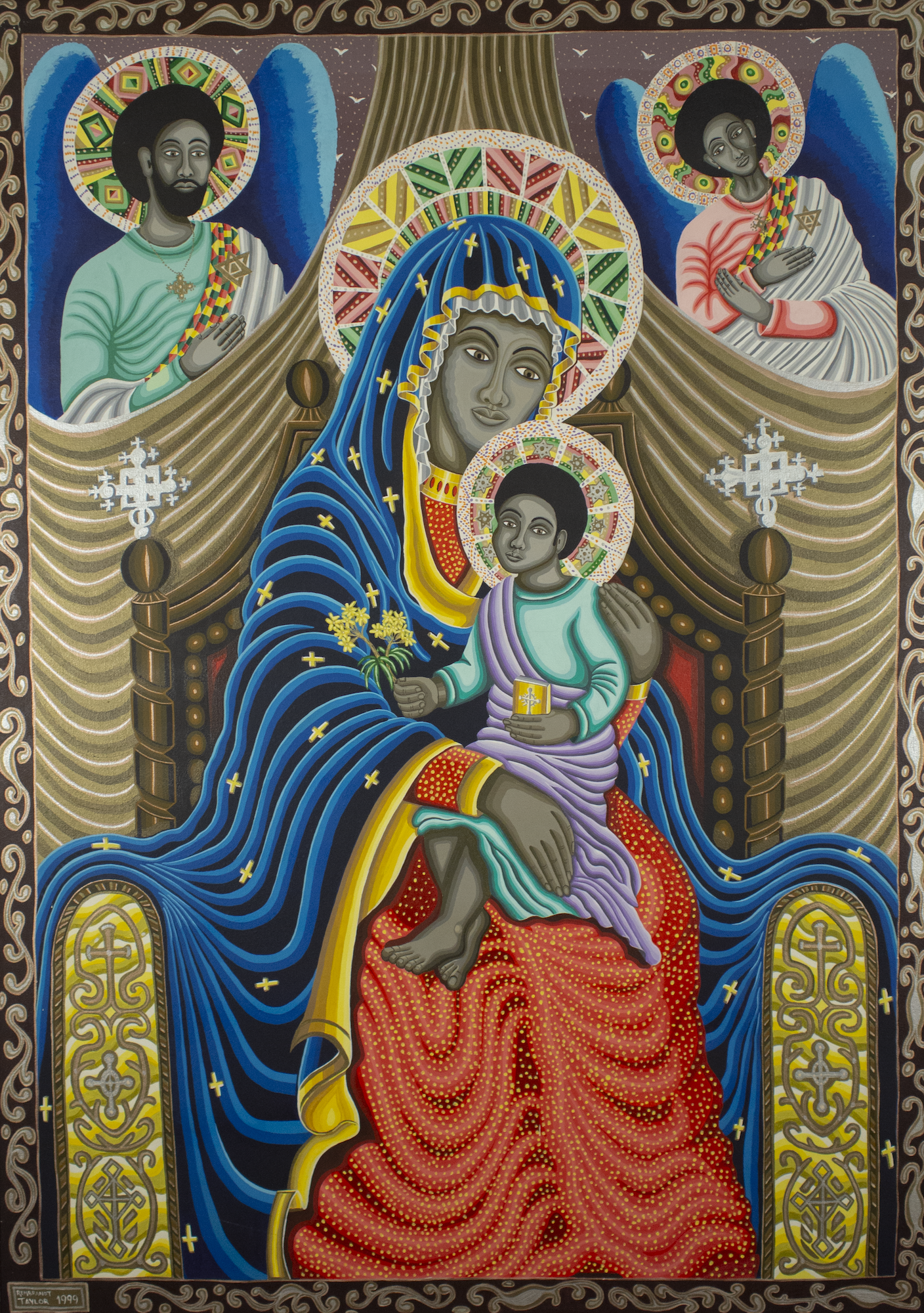
By Natalie Willis
The image of Black Madonna is a symbol of strength, of representations of Blackness and acknowledgement, of embracing Black motherhood as sacred. This doesn’t only extend to Christianity, and we see in this depiction by Rembrandt Taylor embracing his Rastafarian groundings. Taylor’s Untitled (Madonna and Child) (1999) takes symbolism from the Black diaspora, and in a vibrant display gives us a celebratory image of the Virgin Mary and baby Jesus envisioned to look like the majority of the nation, Black and proud. Mary in this image seems just as comfortable with being Madonna as she does with being empress. The foundation of the Rastafari movement, while Abrahamic and making close use of the Christian bible, most importantly hinges on Afrocentrism and the empowerment of Black people the world over – so having Taylor render this most iconic image of the Virgin Mary (most often rendered as a white woman with dark hair) is a significant statement for the elevation of Black women in particular.
Taylor’s version of the Madonna, painted in his cell-shading style that gives an almost digital appearance to the work, especially when thinking of the 90s and early 2000s and Microsoft Paint. It is also deeply patterned, giving an added level of richness to the celebration of the Black Mother. The halos are also very Afrocentric in nature, reminiscent of African wax printed fabric or even Junkanoo, and very importantly, the angels and baby Jesus himself are all sporting the most perfectly picked-out, round afros. Given the political history of Black hair, not just for the Rastafari movement with the dreadlock, but with afros in the 70s and enforced hair covering of women in the American south during slavery and Jim Crow, it’s no coincidence that Taylor would choose to pay close attention to the way that hair is depicted on the holy family.
Some of the first Black Madonna’s date back to the 13th Century in Europe, one of the more well-known works being the 14C Black Madonna of Częstochowa of Poland. This particular Madonna has quite a significance to the Caribbean, as her scarred face and dark skin relate directly to the Haitian Vodou loa (or lwa) “Erzulie Dantor”, who is very often portrayed as Black Madonna with a scarred face. Erzulie is a family of loa, or spirits, in Haitian Vodou, and given the intermixing and adoption of Catholic iconography in Vodou it is not surprising that Erzulie Dantor and her counterpart Erzulie Freda (portrayed as a vain, flirtatious, white Lady of Sorrows version of Mary) take on this more recent tradition though they are some of the oldest and most established loa.
These feminine spirits, dating back to ancient spirits originating in Dahomey (now Benin) which have since been altered and changed and transformed in the Western world (by the Babylon according to Taylor’s beliefs) give us ways to look at the narrow tropes of femininity – the beautiful, the strong woman, the woman who has suffered, the spiteful woman. But it is a shallow way of viewing women, and as such the variety of depictions of the Virgin Mary begin to give way to fighting these tropes, perhaps in part because the Haitian loa (unlike the angelic symbols of perfection of Christian lore) are not perfect beings free from fault. Having this Caribbean grounding of spirits as people of power, who are flawed, and who must work as we do to be good, is more freeing that we give credit for. In making these spirits and gods of immense power more human, and less untouchable or out of reach for us as people, it brings them closer to humanity and in turn renders us closer to divinity and power.
The venerated Black Madonna of Częstochowa shares more than dark skin and scars with Erzulie Dantor and maybe even with Taylor’s Black Madonna, however, she also may be the origin of this particular portrayal of Erzulie. The Polish were stationed in Haiti around the time of the Haitian Revolution in the 1800s, with Napoleon sending a legion of Poles to Saint-Domingue to stave off the slave rebellions happening in 1804. Many of the Polish eventually began to fight alongside the Black slave populace, finding kinship and familiarity in their struggle as Poland was also fighting for its freedom from invading Russia, Prussia and Austria. As history goes, the Poles joined with the enemy they were meant to be fighting against, lending their arms and lives to the cause in the Haitian Revolution and fighting the French who brought them there. It would only make sense then, that perhaps some of the Polish now-citizens of Haiti would have brought this Black Madonna with them, to find her adopted as an apt depiction of Erzulie Dantor.
From Poland’s Black Madonna of Częstochowa (14th Century) with her links to Erzulie Dantor, to Homer Williams’ Bahamian Conception of the Black Madonna and Child (1973)–on long term loan to the NAGB–to this brilliant and elevated Untitled (Madonna and Child) (1999), Taylor’s work sits in good company not just in the Caribbean but the world over for depictions of the holy mother. It is this dizzying variety that makes spiritual and religious art so enticing – we find ways to insert ourselves as marginalised people, to find ourselves in the divine and in the powerful, and to give ourselves agency and our own representation.
Taylor’s work is currently on view at the Bahamas National Trust’s “Rand Nature Center” in Freeport, Grand Bahama, as part of the NAGB’s travelling exhibition of the National Collection. “TRANS: A Migration of Identity” is curated by Richardo Barrett and Abby Smith and will be on view through May 26th, 2019.
